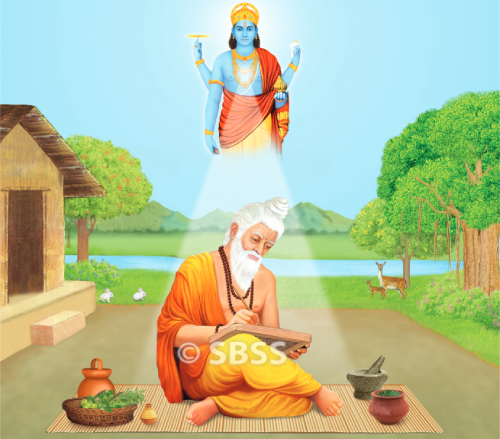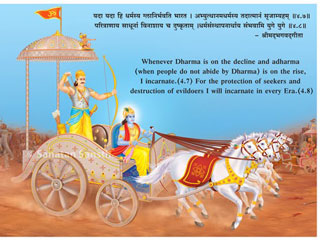Ayurveda for a healthy life ! – 11/2023


2. Exceptional qualities of taste (Rasa)
We have seen the functions of sweet, sour, salty, pungent, bitter and astringent tastes. Some exceptions are given ahead.
A. Usually sweet food items increase the Kapha dosha. But old rice, mung (Green gram), wheat, honey and meat of animals from arid regions do not increase Kapha.
B. All sour food items except pomegranate and amalaki, increase the Pitta dosha.
C. All salty food items except saindhav are harmful for the eyes.
D. All bitter food items except guduchi, snake gourd and bamboo shoots are harmful for the semen and increase the Vata dosha.
E. All astringent food items except haritaki are cool and cause constipation.
F. All pungent food items except sunth (dry ginger), pippali and garlic are harmful for the semen and increase the Vata dosha.
Constitution and the Diet
Vata, Pitta and Kapha are the three biological elements from which all the living cells, tissues, organs and waste products of our body are formed.
A person with an optimal health has all the three biological elements, namely Vata, Pitta and Kapha within normal limits
both, quantitatively as well as qualitatively. Such a person has a balanced constitution (Sama prakruti).
Depending on the dominant dosha which has increased qualitatively, the constitution is labelled as ‘Vata prakruti, ‘Pitta prakruti’ or ‘Kapha prakruti’. Individuals with these constitutions are prone to develop certain diseases. Hence, these constitutions are called as diseased or abnormal constitutions. They never enjoy optimal health. However, they do not realise it, as they are used to the subnormal state of health, right from birth.
As Vata, Pitta and Kapha particles are formed from the food we eat, one can achieve a balanced constitution which is healthy by consuming an appropriate diet.
1. Taste of food items and the doshas
Food items with sweet, sour and salty taste subdue Vata
and increase the Kapha dosha.
Food items with bitter, pungent and astringent taste subdue Kapha and increase the Vata dosha.
Food items with salty, sour and pungent taste increase the Pitta dosha.
Food items having sweet, bitter & astringent taste subdue the Pitta dosha.
The beneficial and harmful diet and activities for people with different constitutions and diseases are listed in the table ahead.
2. Beneficial and harmful diet and activity for Vata constitution and vataja (Vata induced) diseases
| Beneficial diet | Harmful diet | |
| A. Cereals | Rice and wheat | Yava (barley), vari, sattu and ragi (nachni) |
| B. Pulses | Udid (black gram) and kulith (horse gram) | Chana (gram), mung (green gram), chavli (cow peas), tur (red gram), masur (lentil), peas, pavata and sprouted pulses |
| C. Nuts and dry fruits | Kharik (dry dates), figs, walnut, almond and priyala seeds (charoli) | |
| D. Oil seeds | Mustard and til (sesame seeds) | |
| E. Vegetables | Snakegourd, ambada, amlavetas, changeri, drumstick, brinjal, ghosale, onion, suran (yam) and leaves of radish | Karela (bitter gourd), spinach, cucumber, alu (colocasia), ghevada, tondali and dry leafy vegetables |
| F. Fruits | Ripe mango, jackfruit, apple, amalaki, banana, kharbuja, badara (berry), custard apple, grapes, dates and pineapple | Jamun, watermelon and tadgola |
| G. Milk products | Curds, ghee and milk | |
| H. Meat | Meat of aquatic birds, e.g., duck, meat of a camel, frog, donkey, horse, tortoise, beef, pork, mutton and chicken | Dry fish |
| I. Wine/Sugarcane products | Sugarcane juice, sugar and jaggery | Honey |
| J. Spices | Garlic, cumin seeds, saffron, asafoetida, small cardamom, cloves, nutmeg and cinnamon | Betelnut, pepper and chillies |
| K. Food preparations | Kanji and khichadi | – |
| L. Drinking water | Hot water | Cold water |
| M. Taste | Sour, sweet and salty | Bitter, pungent and astringent |
| N. Exercise | Sitting or sleeping in the sun | Excessive walking, hard work and excess of sex |
| O. Purgatives | Eranda (castor) oil | Strong purgatives |
| P. Induction of sweating | Oil massage and bath | – |
| Q. Enema | Enema of til (sesame) oil |
– |
3. Tonics for Vata constitution and Vata induced (Vataja) diseases
Bala, atibala, vidari, til (Sesame seeds), dashamula, jivanti, jivaka, ruihabhaka, meda, mahameda, jyesthamadh (Glycerrhiza), shatavari, hirda, gulvel, vekhanda, punarnava and mandukaparni.
4. Beneficial and harmful diet and activity for Pitta constitution and pittaja (Pitta induced) diseases
| Beneficial diet | Harmful diet | |
| A. Cereals | Yava (barley), wheat, rice and hurda | Red rice |
| B. Pulses | Chana (gram), mung (green gram) and masur (lentil) | Kulith (horse gram), udid (black gram) and sprouted pulses |
| C. Nuts and dry fruits | Dates | Walnut |
| D. Oil | Coconut oil | Mustard oil |
| E. Vegetables | Snakegourd, shirale (ridge gourd), tondali, cucumber, white onion, methi (fenugreek), karela (bitter gourd), ghevada, sweet potato, kushmanda (ash gourd) and tandulja | Brinjal, drumstick, red onion, suran (yam) and kardi |
| F. Fruits | Pomegranate, amalaki (avla), jackfruit, grapes, tender coconut, jamun, banana, shingada (water chestnut) and sweet badra (berry) |
Tamarind, pineapple, oranges, sour badra and raw mango |
| G. Milk products | Cow’s milk, butter and ghee | Curds, buttermilk and sheep’s milk |
| H. Meat | Meat of a rabbit and deer, mutton and shellfish | Meat of a sheep and buffalo, chicken, beef and fish |
| I. Sugarcane products | Sugarcane juice and sugar | Jaggery |
| J. Spices | Saindhav, small cardamom, coriander seeds and cumin seeds | Ajamoda (celery), garlic, asafoetida, pepper, mustard and chillies |
| K. Drinking water | Cold water | Hot water |
| L. Water for bath | Cold water | Hot water |
| M. Taste | Astringent, sweet & bitter | Pungent, sour and salty |
| N. Exercise | – | Excessive walking, riding on a horse or an elephant |
| O. Miscellaneous | Sleeping on the floor | Getting angry, smoking & sitting for long periods in the sun |

 Radiant Thoughts of Sachchidananda Parabrahman (Dr) Jayant Athavale
Radiant Thoughts of Sachchidananda Parabrahman (Dr) Jayant Athavale Law banning Conversion of Religion is against Individual Freedom : Babbles Former Judge S Muralidhar
Law banning Conversion of Religion is against Individual Freedom : Babbles Former Judge S Muralidhar Editorial : Khalistan, Balochistan and Pakistan
Editorial : Khalistan, Balochistan and Pakistan After India becomes a ‘Hindu Rashtra’, Russia will embrace Hinduism and spread it globally : Nostradamus’ Prophecy
After India becomes a ‘Hindu Rashtra’, Russia will embrace Hinduism and spread it globally : Nostradamus’ Prophecy ‘Halt Public Spending on Aurangzeb’s Tomb, Prioritise Maharashtra’s Heritage’ : HJS
‘Halt Public Spending on Aurangzeb’s Tomb, Prioritise Maharashtra’s Heritage’ : HJS Noise Pollution, Loudspeakers, and the Law
Noise Pollution, Loudspeakers, and the Law